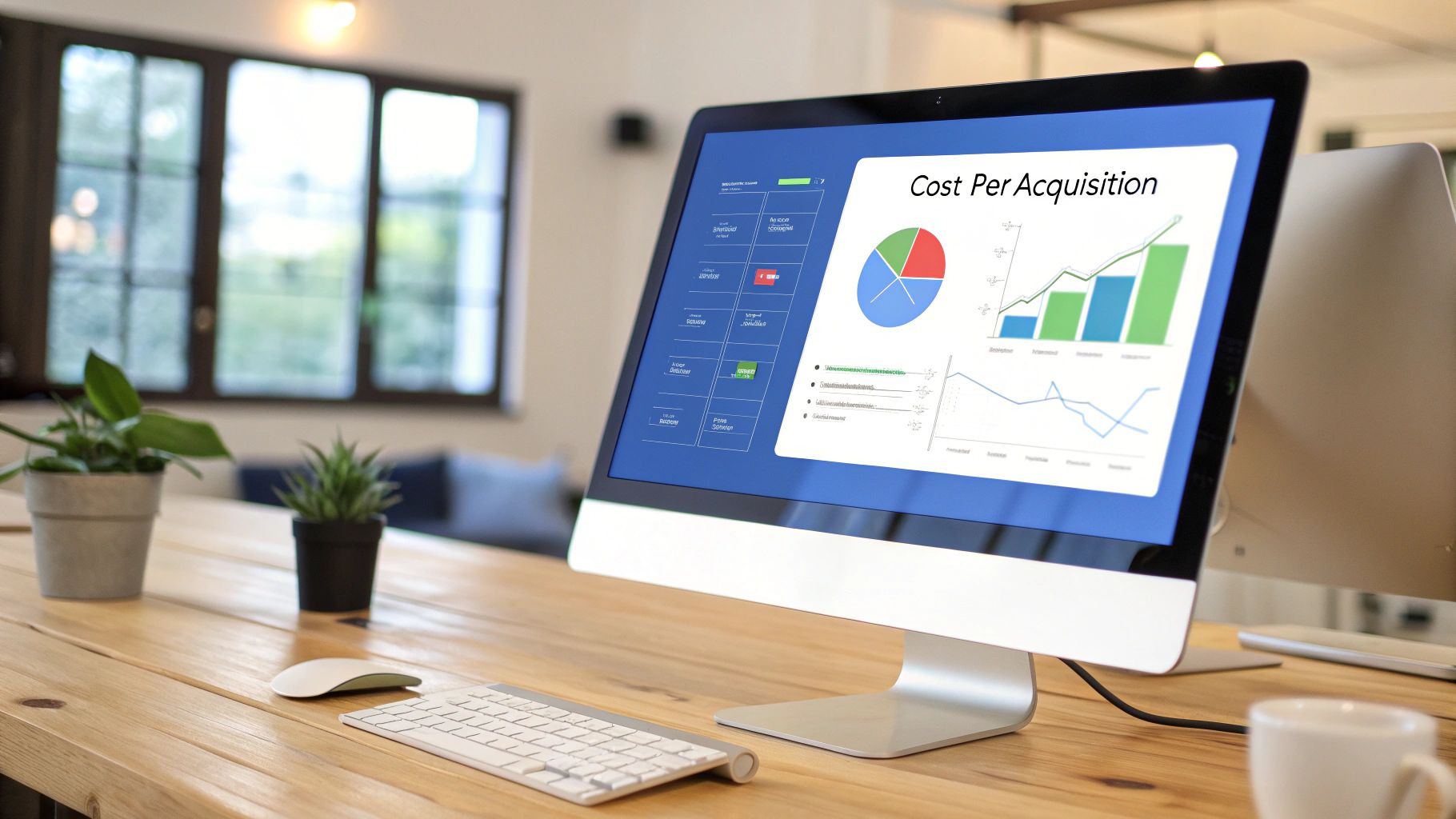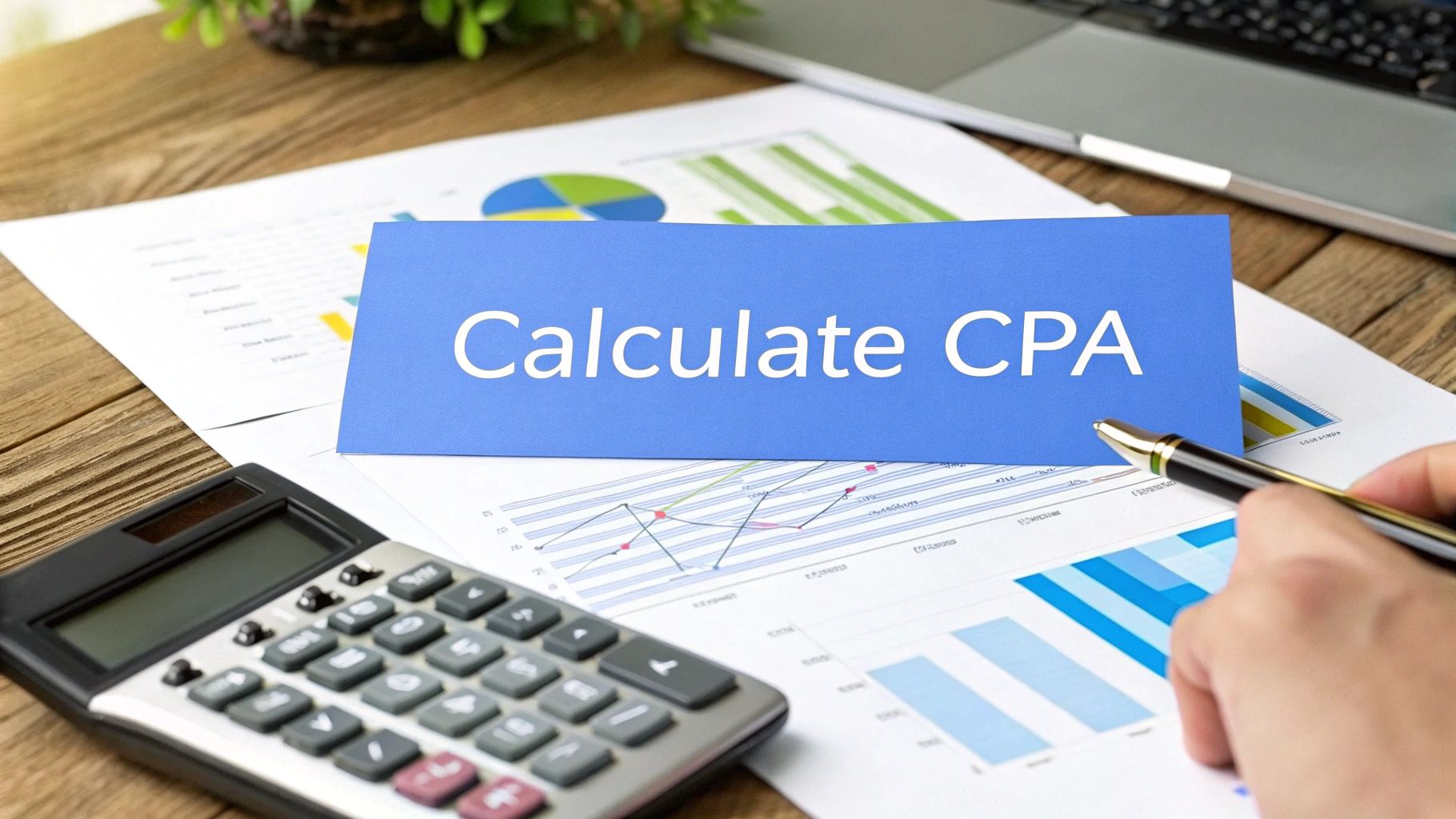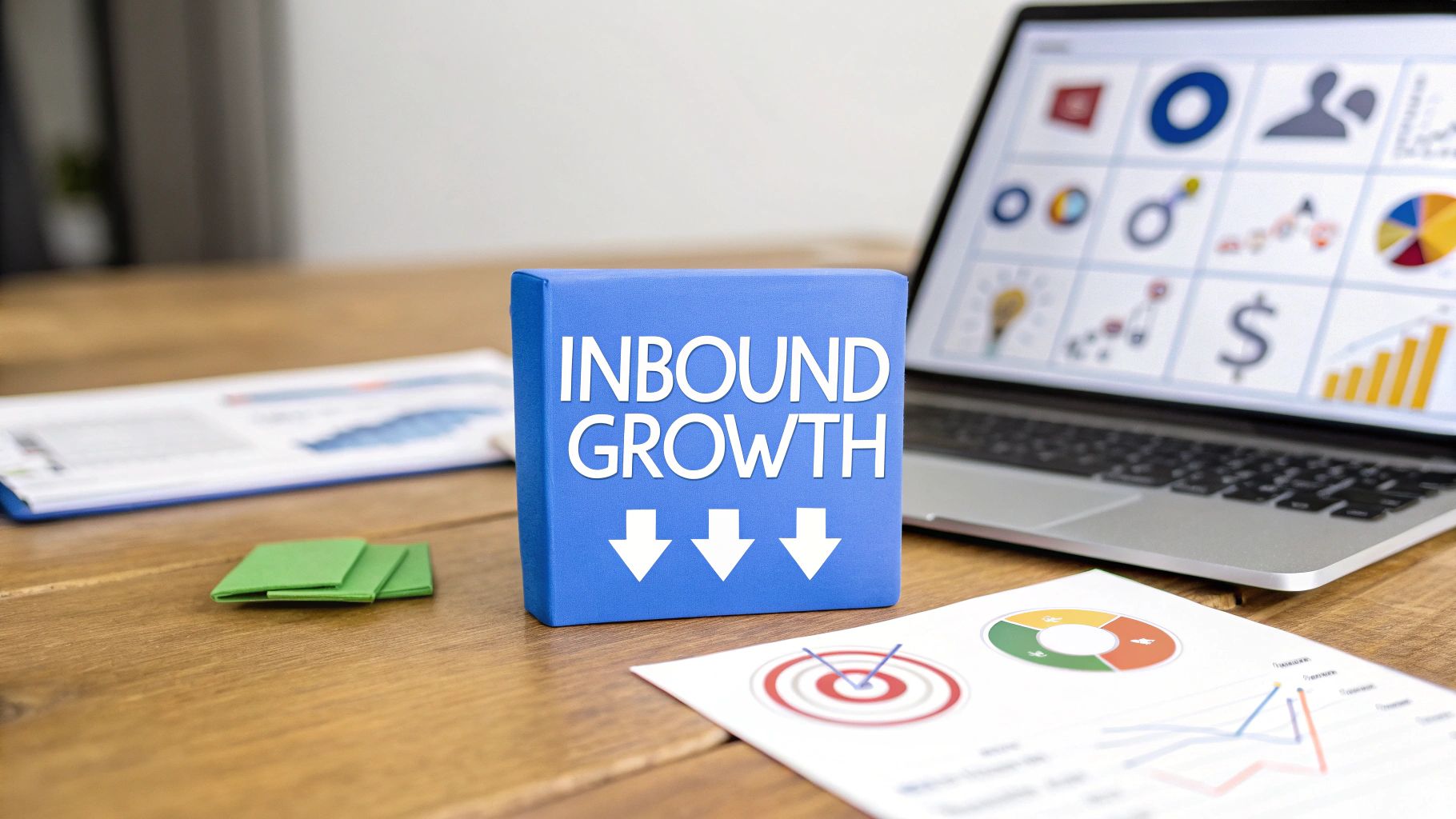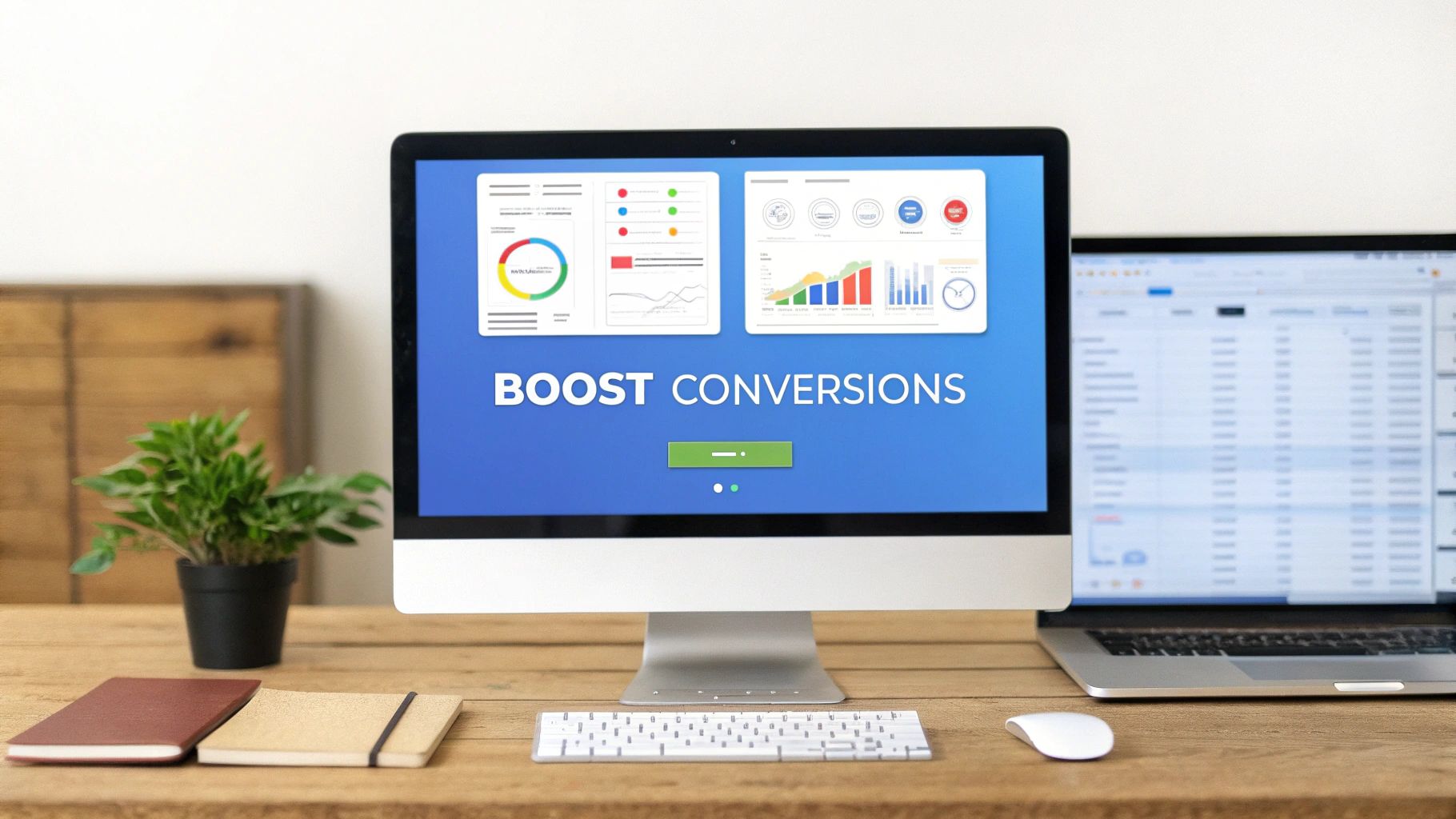Summary
Ready to discover what it really costs to land a new customer? It's simpler than you might think. The key metric you need is your Cost Per Acquisition (CPA).
So, how do you calculate cost per acquisition?
Just take the total amount you spent on a marketing campaign and divide it by the number of new customers you won from that specific effort. This single metric cuts through the noise. It tells you exactly how much you're spending for each conversion, making it a non-negotiable health check for your marketing budget.
What is Cost Per Acquisition and Why Does It Matter?

Cost Per Acquisition is more than just a formula—it's the clearest signal you have for marketing efficiency. Frankly, it tells you if your business is built to last. It’s the metric that separates campaigns that just look busy from those that are actually profitable.
Think about it: a high CPA might mean you're bleeding cash without a decent return. On the other hand, a low one is a fantastic sign that you've hit on a winning strategy.
So, what does this number truly reveal? Knowing your CPA helps you make smarter, more confident decisions with your marketing dollars.
Let’s use a quick example. Imagine you spent $10,000 last month on all marketing activities—ads, content, the works—and brought in 100 new customers. Your CPA would be $100. Simple as that. For a deeper dive into this type of analysis, Umbrex offers a great guide on CPA analysis.
The Strategic Value of CPA
Obsessing over this metric is how you move from guesswork to a data-driven strategy. It gives you clear, undeniable answers to your most pressing marketing questions.
By consistently tracking your CPA, you can:
- Allocate your budget smarter: Funnel resources into the campaigns and channels that deliver customers at a lower cost.
- Identify your most profitable channels: Is Google Ads outperforming your social media efforts? Your CPA will lay it all out.
- Measure true ROI: Finally answer the ultimate question every marketer faces: "Is what I'm doing actually making the company money?"
To get your CPA calculation right, you need to be honest about all the costs involved. Here's a quick look at what should be included.
Breaking Down the CPA Formula Components
Being thorough here is crucial. If you leave costs out, you're only fooling yourself with a lower, inaccurate CPA.
Ultimately, CPA isn't just a reporting metric; it's a compass. It guides your spending, justifies your marketing efforts, and directly connects your campaigns to the company's bottom line.
Understanding this and other crucial advertising performance metrics is fundamental to building a marketing engine that not only runs but scales successfully. Without a firm grasp on how much it costs to acquire a customer, you're essentially flying blind.
Gathering the Right Data for an Accurate CPA
To get a real, honest-to-goodness CPA, you need clean data. It’s that simple. Garbage in, garbage out. A flawed number will give you a false sense of security or send you into an unnecessary panic.
It all starts with being ruthlessly honest about what you're actually spending. The "Total Cost" part of the formula is where most marketers trip up. It’s easy to just count ad spend, but that’s barely scratching the surface of your real investment. For a true picture, you must include every single expense that helped win a new customer.
This infographic breaks down the core data gathering process into three clear stages.

As you can see, a reliable CPA calculation starts by getting all your costs in a row before you even peek at your acquisition numbers.
Defining Your Total Campaign Costs
Think beyond the obvious. Your total costs should be a complete list of every dollar spent on the acquisition effort during a specific period. What does that include? Let’s dig in.
- Direct Ad Spend: This one’s easy. It’s the cash you paid directly to platforms like Google Ads, LinkedIn, or Facebook.
- Team Salaries: You need to factor in a portion of the salaries for the marketing and sales folks who actually worked on the campaign. Their time isn't free.
- Software and Tools: Don't forget the subscription costs for your CRM, analytics platforms, email marketing software, and any other tools you used to make it all happen.
- Agency or Freelancer Fees: Did you bring in outside help? Any payments made to external partners for their services belong here.
- Content and Creative Production: This covers the costs tied to creating the ads, landing pages, videos, or any other campaign assets.
Missing even one of these components will artificially lower your CPA, making an unprofitable campaign look like a big win. It’s far better to have a higher, accurate CPA than a lower, misleading one.
Identifying and Tracking New Acquisitions
Once you've tallied up all your costs, the next step is nailing down what a "new acquisition" actually means for your business. Is it a completed purchase? A signed contract? A new paid subscriber? You need to be specific and, more importantly, consistent.
From there, you need a solid attribution model to connect these new customers back to your campaigns. This is where tools like Google Analytics and your CRM become your best friends. By setting up proper conversion tracking, you can confidently assign credit to the right channels.
If you want to get better at this, check out our guide on how to measure marketing campaign success for some deeper insights.
Key Takeaway: An accurate CPA is built on two pillars: a complete accounting of all associated costs and a precise count of verifiably new customers. Cutting corners on either one will undermine your entire analysis.
Putting the CPA Formula to Work: Real-World Scenarios
Theory is great, but let's be honest, the real learning happens when the rubber meets the road. Seeing the Cost Per Acquisition formula in action with actual business examples is where you get that "aha!" moment. It's how you move from just knowing the formula to truly understanding your marketing performance.
Let’s walk through a couple of common marketing scenarios to see exactly how this plays out. We'll break down all the costs and count up the conversions to get a clear, actionable CPA.

E-Commerce Example: A TikTok Influencer Campaign
Picture an online shop that sells sustainable activewear. They decide to team up with a TikTok influencer for a month-long push to promote a new collection.
Here’s what they spent to make it happen:
- Influencer Fee: $2,500 for a package of posts and stories.
- Product Seeding: $500 in free gear sent to the influencer.
- Ad Spend: $1,000 to boost the influencer’s top-performing content to a wider audience.
- Team Time: An estimated $1,000 of the marketing manager's salary dedicated to this campaign.
All in, their total investment was $5,000. By using a unique discount code and UTM tracking, they could attribute 125 new customers directly to the campaign.
CPA = $5,000 (Total Cost) / 125 (New Customers) = $40
So, each new customer acquired from this TikTok campaign cost them $40. This number is incredibly valuable. When you consider that rising ad competition has driven e-commerce acquisition costs up by around 40% lately, that $40 CPA starts to look pretty good.
SaaS Business Example: A LinkedIn Ads Campaign
Now, let's switch gears to a B2B SaaS company. Their goal is to drive new paid sign-ups for their project management software, so they launch a targeted LinkedIn Ads campaign for one quarter.
Here's the cost breakdown:
- LinkedIn Ad Spend: $15,000
- Content Creation: $3,000 for producing video ads and designing the landing page.
- Software Fees: $500 for various analytics and landing page tools.
Their total campaign cost adds up to $18,500. At the end of the quarter, their tracking shows 100 new paid subscribers came directly from this LinkedIn effort.
CPA = $18,500 (Total Cost) / 100 (New Subscribers) = $185
For this SaaS business, the cost to acquire a single paying subscriber was $185. If you want a more detailed guide on crunching these numbers, check out this excellent resource on how to calculate customer acquisition cost.
As you can see, the same simple formula works perfectly for two completely different business models and marketing channels. It gives you a universal way to measure what’s working and what’s not.
How to Interpret Your CPA for Better Decisions
Alright, you've calculated your Cost Per Acquisition. Now what?
The number itself doesn't mean much in a vacuum. A common mistake is jumping to conclusions, asking if your CPA is "good" or "bad" without any context. Your CPA is just a data point—the real magic happens when you start interpreting it.
https://www.youtube.com/embed/JfUQJfr5kB0
The single most powerful way to give your CPA meaning is to stack it up against your Customer Lifetime Value (LTV). LTV is the total revenue you can expect to earn from a single customer over the entire time they do business with you. Once you know your LTV, your CPA suddenly tells a much more interesting story.
The LTV to CPA Ratio: Your North Star
For any business looking to grow sustainably, the ideal LTV to CPA ratio is 3:1.
Think about it this way: for every dollar you spend to bring a new customer in the door, you should be getting at least three dollars back over their lifetime. A 1:1 ratio means you're just breaking even on your marketing efforts. Anything less than that, and you're actively losing money on every new customer you sign up.
A healthy 3:1 LTV to CPA ratio isn't just a vanity metric—it's a clear signal that your business has a viable, scalable growth engine. It confirms your marketing is not just an expense but a profitable investment.
Benchmarking Against the Industry (and Yourself)
It can be helpful to see how your CPA stacks up against industry averages to get a general feel for where you stand. And costs are definitely on the rise. Between 2013 and 2021, the average customer acquisition cost shot up by a staggering 222%.
Some industries are notoriously expensive. For instance, fintech companies can expect to pay around $1,450 per customer, while insurance is close behind at $1,280. These are worlds away from channels like email marketing, which averages closer to $510. You can find more of these customer acquisition cost statistics on amraandelma.com.
But here’s the thing: while industry numbers are interesting, the most important benchmark is your own history. How does this month's CPA compare to last quarter's? Tracking your own trends over time is far more insightful than chasing someone else's average.
Finally, get granular and segment your CPA by channel. You'll almost certainly find that your Google Ads CPA is completely different from your organic SEO or social media CPA. This is where you strike gold. By breaking it down, you can pinpoint your true cash cows and identify the channels that are just draining your budget, allowing you to reallocate your spend for maximum impact.
Actionable Strategies to Lower Your Cost Per Acquisition

Knowing how to calculate your CPA is the easy part. The real work—and the real growth—comes from actively driving that number down. A high CPA isn't a failure; it’s a flashing sign pointing you toward optimization opportunities.
The goal here isn't just to find cheaper customers. It's about building a smarter, more efficient marketing engine that brings in high-value customers without breaking the bank.
Think about it this way: every dollar you shave off your CPA is another dollar you can reinvest to acquire the next customer. This creates a powerful compounding effect that can seriously accelerate your growth. Ready to make your budget work harder for you?
Optimize Your Landing Pages and Funnels
Let's be blunt: your landing page is where conversions live or die. If your page is confusing, slow, or totally irrelevant to the ad they just clicked, you're just paying for people to leave. That sends your CPA through the roof.
The fix is a relentless focus on Conversion Rate Optimization (CRO). Start by A/B testing the elements that truly matter:
- Headlines: Are you speaking directly to a pain point? Test different angles and see what resonates.
- Calls to Action (CTAs): Don't just settle for "Submit." Experiment with different button colors, text ("Get Started" vs. "Book a Demo"), and even placement on the page.
- Forms: Shorter is almost always better. Every field you remove is one less reason for someone to give up. Even a tiny 1% bump in your conversion rate can have a massive impact on your CPA.
Sharpen Your Ad Targeting
Stop throwing money at audiences that will never convert. It's one of the most common mistakes I see. The more precise your targeting, the lower your acquisition cost will naturally become.
You need to get granular, especially on platforms like Google Ads and LinkedIn.
Pro Tip: Get aggressive with negative keywords and audience exclusions. Telling Google who not to show your ads to is one of the fastest ways to slash wasted spend and bring your CPA down.
Don't just stop at basic demographics. Dig deeper. Refine your targeting to focus on high-intent behaviors. Better yet, build lookalike audiences from a list of your best existing customers. A lower CPA often goes hand-in-hand with a higher Customer Lifetime Value (LTV).
For more on that, check out our guide on improving customer lifetime value. And if you're looking for more in-depth strategies to get your spending under control, explore these proven ways to reduce your Customer Acquisition Cost.
Common Questions About Cost Per Acquisition
Even once you get the formula down, some practical questions always pop up when you start putting CPA tracking into practice. Let's run through a few of the most common ones.
What is the difference between CPA and CAC?
It’s easy to get these two mixed up, and you’ll often see them used interchangeably. But there's a small, important difference.
Customer Acquisition Cost (CAC) almost always refers to the total cost of landing a brand new paying customer. It's the whole enchilada.
Cost Per Acquisition (CPA), on the other hand, can be a bit broader. You might use CPA to measure the cost of something that isn't a final sale—like a lead, an email signup, or a free trial user. The trick is to clearly define what an "acquisition" means for each specific campaign and then stick to it for consistency.
How often should I calculate CPA?
Honestly, this boils down to your sales cycle.
If you’re running a fast-moving e-commerce store, checking your CPA weekly is smart. It lets you pivot your campaigns and adjust your ad spend before you burn through your budget.
But for a B2B company with a sales process that takes months, a weekly check-in won't tell you much. In that case, calculating CPA monthly or even quarterly will give you a much more stable and meaningful picture of your performance.
For most businesses, a monthly check-in is the perfect place to start.
Is a high CPA always a bad thing?
Not at all. This is a huge misconception.
A high CPA is only a problem if it's eating up your profits. The real metric to watch is the relationship between your CPA and your customer's Lifetime Value (LTV).
A $1,000 CPA might sound terrifying on its own. But if that customer goes on to generate $10,000 in revenue over their lifetime, it’s an absolutely brilliant investment. Context is everything.
Ready to slash your CPA and maximize your Google Ads ROI? LanderMagic creates lightning-fast, AI-powered landing pages that convert clicks into customers. Discover how LanderMagic can transform your campaigns today!









